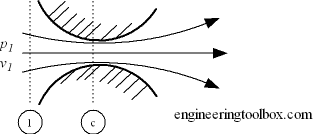Nozzles
Gas flow through nozzles and sonic chokes.
The maximum gas flow through a nozzle is determined by critical pressure.
- critical pressure ratio is the pressure ratio where the flow is accelerated to a velocity equal to the local velocity of sound in the fluid
Critical flow nozzles are also called sonic chokes. By establishing a shock wave the sonic choke establish a fixed flow rate unaffected by the differential pressure, any fluctuations or changes in downstream pressure. A sonic choke may provide a simple way to regulate a gas flow.

The ratio between critical pressure and initial pressure for a nozzle can expressed as
pc / p1 = (2 / (n + 1))n / (n - 1) (1)
where
pc = critical pressure (Pa)
p1 = inlet pressure (Pa)
n = index of isentropic expansion or compression - or polytropic constant
For a perfect gas undergoing an adiabatic process the index - n - is the ratio of specific heats - k = cp / cv. There is no unique value for - n. Values for some common gases
- Steam where most of the process occurs in the wet region : n = 1.135
- Steam superheated : n = 1.30
- Air : n = 1.4
- Methane : n = 1.31
- Helium : n = 1.667
Example - Air Nozzles and Critical Pressure Ratios
The critical pressure ratio for an air nozzle can be calculated as
pc / p1 = (2 / (1.4 + 1))1.4 / (1.4 - 1)
= 0.528
Critical pressures for other values of - n:
| n | 1.135 | 1.300 | 1.400 | 1.667 |
| pc/ p1 | 0.577 | 0.546 | 0.528 | 0.487 |
Mass Flow through Nozzles
The mass flow through a nozzle with sonic flow where the minimum pressure equals the critical pressure can be expressed as
mc = Ac (n p1 ρ1)1/2 (2 / (n + 1))(n + 1) / 2(n - 1) (2)
where
mc = mass flow at sonic flow (kg/s)
Ac = nozzle area (m2)
ρ1 = initial density (kg/m3)



